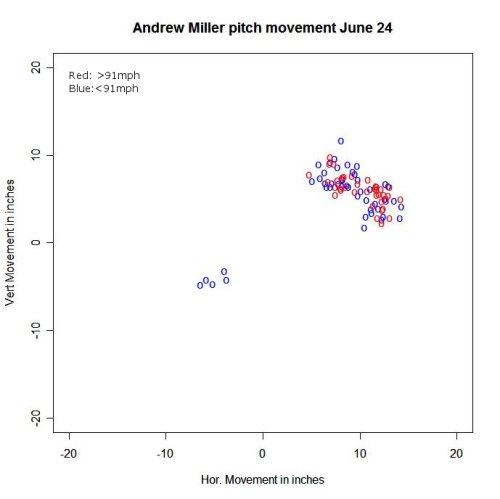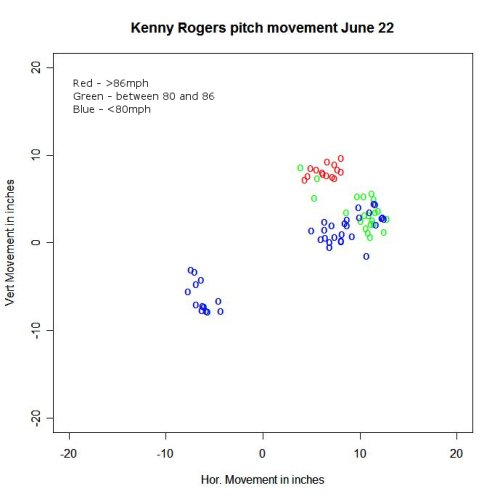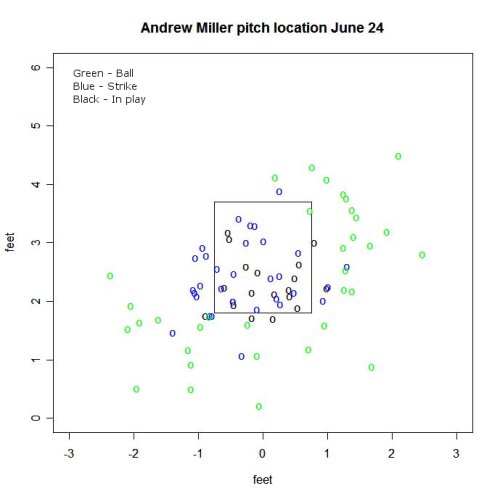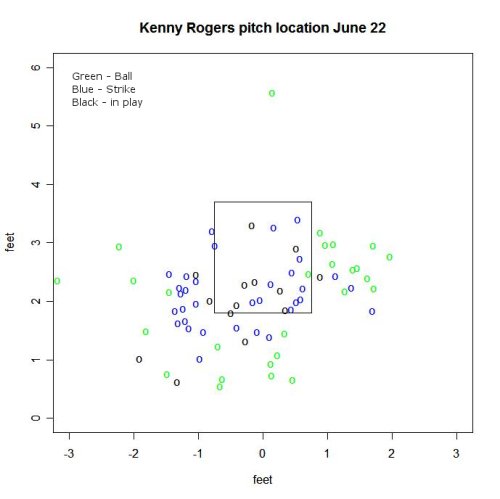On Sunday, June 24th Andrew Miller took center stage on ESPN Sunday Night Baseball and promptly pitched 6 shut out innings. Miller only allowed 4 hits and 2 walks and was never really threatened. Was this a dominant performance by a young stud pitcher, or just another day at the office for the slumping Braves? I don’t know if we can really say one way or the other, but with enhanced gameday data we can at least get some additional information.
If you are a new reader, MLB’s new gameday has a series of cameras set up in 8 major league parks that captures pitch speed, location, trajectory, and release point. I’ve used this data to look at Joel Zumaya and Jeremy Bonderman in the past. Others have looked at the consistency in data between parks, how pitches sink, and a variety of other studies. But back to the task at hand.
The first thing to look at the mix of pitches that Andrew Miller was throwing. If you watched the game, it was clear that Miller was relying on his fastball. In fact, only 7 of the 84 pitches that gameday tracked were less than 83mph. The rest of the time Andrew Miller was throwing between 87 and 94mph for the most part.
Joe Morgan repeatedly commented that Andrew Miller was throwing 2 different fastballs, and if you look at the plot of pitch speeds it does look possible. So there were a couple different speeds, but did they have different movement? The chart below shows the horizontal and vertical movement. The movement is defined as the distance from where the pitch crossed the plate, and where a hypothetical pitch with no spin would have crossed the plate. A pitch with no spin would be expected to go down due to gravity, but the backspin on the fastball helps to counteract that. So the positive value in vertical movement doesn’t mean the ball rises, just that it drops less than a pitch with no backspin.

The couple of breaking pitches that Miller threw really stand out. But focusing on the fastballs, by looking at the movement it does appear that there was a little variation. There was a cluster of pitches that have about 3 to 6 inches of vertical movement and a little more tailing and then another cluster that had 6-10 inches of vertical movement and were straighter. Presumably the former would be the 2 seamer and the latter would be the 4 seamer. What is a little surprising is that he mixed the speeds between the two pitches. He threw the straigher pitch slower and the sinking pitch faster. It makes for less delineation between the 2 pitches.
As a point of comparison, here is Kenny Rogers chart from just 2 nights before:

Now of course Rogers has a different repertoire so this isn’t a great comparison, but the pitch types become pretty distinct. I don’t know if in Miller’s case the lack of distinction was by design, or if it comes from still refining his pitches but it did prove effective.
So we know that Miller was relying on his fastball, that may have in fact been 2 different fastballs. Still though, it would be tough to keep a team off the board without throwing a breaking or offspeed pitch all night. So maybe Miller was a master of control. Here’s a chart of where he threw the pitches (from the catcher’s perspective).

What I notice from the chart is that he didn’t get a lot of swings and balls that weren’t right near the strike zone. Without breaking pitches, hitters were less inclined to chase. At the same time he did do a nice job getting strikes on the inner half to right handers.
The next chart shows Kenny Rogers outing from Friday. You can see that he hardly threw the fastball over the middle of the plate. He picked up a ton of strikes that were well out of the strike zone and was consistently working in the bottom half.

And one final item is to look at what happened to each of those pitches that Miller threw:
- 36 Balls
- 17 Called Strikes
- 15 Fouls
- 20 in play
- 0 Swings & Misses
Despite the raw stuff, Miller didn’t induce a single swing and miss. Now granted there wasn’t much solid contact either.
In the end I’m less inclined to call that effort a dominating performance. It was certainly a strong outing, and it’s probably a testament to his fastball(s) that he was able to do what he did with only one pitch. The Atlanta Braves came into that game slumping, and facing Miller certainly did nothing to help them out of it. He still had good movement on the fastball, plus with his frame and delivery he’ll still give the opposition fits. Plus this was just one start, and he has thrown the slider/curve more in the past. So I’m not predicting doom and gloom, but he’ll have to find a way to command his secondary pithces.
Billfer has a consistent journalistic slant oozing with Hater-aid towards Miller. Billfer would rather see Miller ripening until the year 2020 in some amateur Single A League from Nantucket. After today’s gem by Miller, Billfer will be forced to drop this ultra conservative agenda and join forces with the Dead Rabbit.
Billfer has no slant of hater-aid towards Andrew Miller. Billfer loves Andrew Miller and has been impressed with the results thus far. Billfer thinks that Mr. Miller would benefit in the long run by making another 8-12 starts at the minor league level.
Wow, a lot of effort there to parse the point of whether Miller’s effort was strong or dominant. The guy is the #5 starter, don’t we think we’re over-thinking this? If he struggles, say, in three straight starts, he’ll get sent to AAA. There will be no harm done, he’ll have had a real taste of the big leagues either way. Miller is not being harmed by this experience whatsoever whether he fails or succeeds.
I feel like I just looked a bunch of those posters where if you stare long enough you will see a 3-D image of a skyscraper or something. 😉
Man, all I can see are spots on my screen. Oh, I love the 3rd person response by The Billfer – reminds me of an old Seinfeld episode, “Jimmy likes Elaine” or something like that.
Anyhoo –
I think Billfer is concerned that Miller might not have the opportunity to fully develop his arsenal of pitches at the Major League level. Billfer is just thinking long term.
Thanks for the data, Billfer.
PS is the game still at 3:55 this afternoon?
Can you use the pitch movement data to color-code the pitch location chart by pitch type? I’d love to see what patterns appear.
As long as the Detroit Tigers are in contention and Miller is one of the top ten pitchers on the team he belongs in the majors. It just seems dealing with Miller immediate future is profoundly down the list of actual important things to worry about this team. I’d worry about these few things:
1. The relief pitching putting out fires with gasoline.
2. A first baseman with 400 plus Tigers ab’s whose 06-07 slugging % is only 20 points higher than Mike Hampton’s career slugging % and well below Rick Rhoden’s best four or five years. And I’m pretty sure at fiftysomething Rhoden could still beat Casey in a foot race. But then again so could a dead mule.
3. Mr. Platinum Sombrero still getting ab’s.
4. Whether Lamont’s potbelly will blot out the sun.
Nah, he doesn’t “belong” in the majors. He “belongs” developing his change-up and his confidence in using his breaking ball. If he were to throw more breaking balls i’d be more optimistic but he’s not. When he threw them to Morneau he made him look foolish on 4 straight breaking balls before K’ing him.
But he’s strayed away from that and if he doesn’t make the adjustment he’s going to get rocked. Anyone can hit a fastball in the majors. Look at Zumaya early in the year when he was throwing nothing but gas, he was getting hit and being wild until he started using his breaking ball again.
I trust Leyland with the devolopment of talent. Miller has the ‘stuff’ to be in the majors. I wonder if he benefits from throwing after Verlander, but before Bonderman in the rotation? Verlander puts guys into slumps…then Miller can get by throwing fast balls (from the other side).
I am getting tired of the Tom Gage “Bonderman works to devolop a change up” article every spring training. I hope they emphasis this will Miller more than they did with Bonderman (different pitching coach).
Miller is going to get shut down for a couple of starts in August/Sept anyway, so for anyone who wants to see Durbin, you will get your wish.
Thanks for breaking that down Billfer